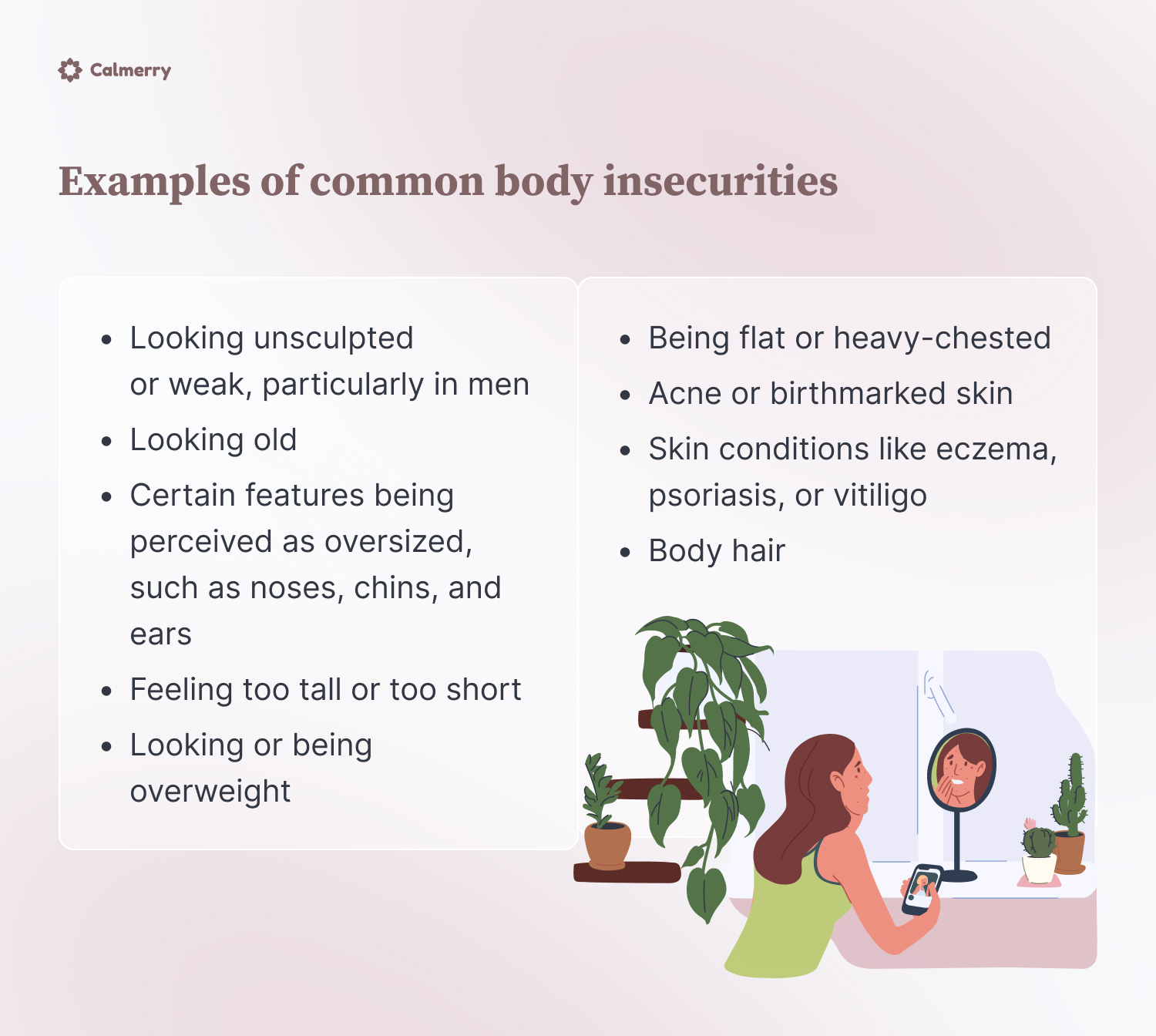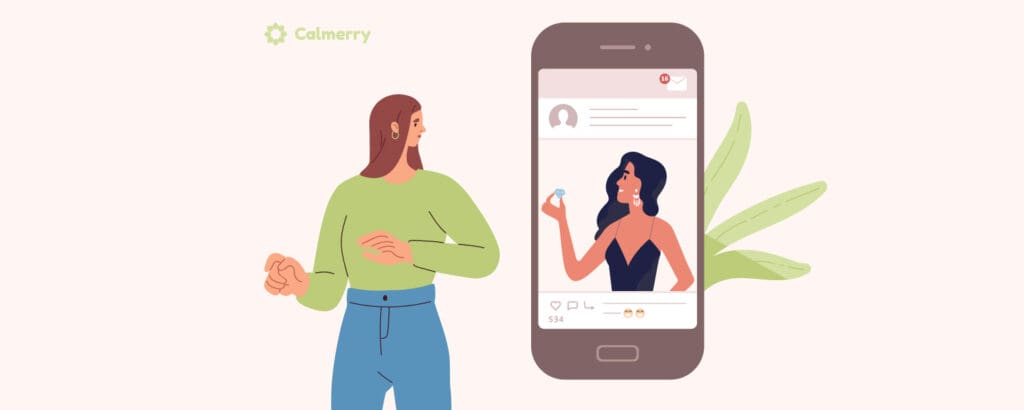Overcoming Insecurities About Your Body: A Guide to Embracing Self-Acceptance

In this article
In today’s world, we are exposed to more people than previous generations ever believed was possible.
Only a hundred years ago, you were only exposed to photographs and people you could physically see in front of you. Today? We see hundreds, if not thousands, of different people every single day through TV, movies, and social media, along with those we encounter in real life.
With so many options for what a person could look like, you’d think we would have eliminated body insecurities, right?
Wrong.
The market for adjusting our body appearance is huge, all in service of making us feel more ideal, whatever that ideal is. Plastic surgery and non-invasive aesthetic treatments such as lip fillers continue to grow in popularity, with over 30% and 50% increases in a span of four years, respectively.
Filters and photo editing run rampant throughout social media platforms. The modern beauty industry has even made 12-step skincare routines a hot trend for young girls who have not even hit puberty.
Self-doubt related to physical appearance has become increasingly common in recent years. Many of us experience feelings of shame and insecurity about our appearance. In this step-by-step guide, let’s discuss where insecurity about the body comes from and how to overcome it.

Common Causes of Body Insecurities
Societal and media influence
The unrealistic standards portrayed in the media significantly contribute to why so many people feel insecure about their appearance. Social media constantly cultivates images of perfect-looking bodies, shiny hair, and happy smiles. When we constantly see digitally altered images portraying “perfect” looks, it becomes easy to develop negative self-talk about our own bodies.
Social media comparisons can be particularly damaging to our self-image. Studies show that frequent social media use correlates with increased appearance concerns. These platforms often curate an idealized version of reality that doesn’t reflect most people’s authentic selves.
In the age of AI, social media influence has become even more significant, as the internet is now filled with retouched, idealized, or even fully generated images that set a new high in physical appearance.
Personal experiences and upbringing
It can be hard to identify the first time you ever felt self-conscious about your appearance. Some individuals might not even remember a time when they felt free and comfortable in their own skin.
Criticism or body shaming, especially intentionally making someone feel humiliated, begins early in life. Past experiences, especially during formative years, can shape how we perceive ourselves long into adulthood.
One study showed that even prepubescent children, especially girls, report concerns and dissatisfaction with how they look, beginning as young as five years old.
These frustrations do not come from the inability to grow butterfly wings or have long and shiny hair, either. Very explicitly, these girls want to be thinner.
A Canadian review of adolescent dieting in English-speaking countries indicated that roughly more than half of teenage girls and one-fifth of teenage boys have attempted weight loss at some point in their lives. [2] Davison, K. K., Markey, C. N., & Birch, L. L. (2003). A longitudinal examination of patterns in girls’ weight concerns and body dissatisfaction from ages 5 to 9 years. International Journal of Eating Disorders, 33(3), 320–332. https://doi.org/10.1002/eat.10142
With statistics like these, it’s no wonder that self-esteem issues are so prevalent among both women and men.
Family culture
For very young children, the first people they engage with, in any capacity, are their families. Parents and older family members model behaviors for toddlers, who then learn how to be self-critical about their appearance.
Sometimes, these family members intend to help the child learn about healthy habits. Unfortunately, they instead teach the child how to find parts of themselves unworthy of acceptance.
Trauma and its impact
Those who experience trauma at a young age may look for ways to displace the discomfort of what has happened to them.
Many who have experienced trauma feel tremendously unsafe in their physical form. In some cases, this can lead to highlighting certain features and parts of themselves and even blaming them for the trauma.
“This creates an immense amount of shame and fear surrounding embracing one’s physical self.”
– Alicia Ortega, Therapist-turned mental health writer
Psychological factors
Psychological factors like perfectionism often drive appearance struggles that can be difficult to overcome. When we hold ourselves to impossible standards, we set ourselves up for a negative self-image and constant disappointment.
Low self-esteem and anxiety disorders can further exacerbate how we view ourselves. Constant self-judgment is often a symptom of deeper mental issues that can be rooted in past traumas. These conditions might make us hyperaware of perceived flaws that others might not even notice in daily interactions.
Cultural and gender expectations
Even before the dawn of the iPad, kids and social media, as well as people outside the home, had influenced how we see ourselves. Many times, when some of us have asked, “Why am I so insecure about my body?” the answer comes from early shaming experiences in elementary school.
Societal pressures create different expectations for different genders that can fuel insecurity. Men often feel pressured to appear strong and muscular, while women frequently face pressure to remain youthful and thin.
As we get older and pursue romantic relationships, potential partners may highlight certain things they find unattractive. This feedback can make us feel insecure if we possess those traits, reinforcing negative beliefs about ourselves.
Examples of common body insecurities
Common physical self-doubt struggles may include:
- Concerns about weight or size
- Looking unsculpted or weak, particularly in men
- Looking old or showing signs of aging
- Certain features being perceived as oversized, such as noses, chins, and ears
- Being flat or heavy-chested
- Acne or birthmarked skin
- Skin conditions like eczema, psoriasis, or vitiligo
- Feeling too tall or too short
- Hair patterns or distribution
How body insecurities affect mental health
Appearance insecurities can significantly impact mental health when they begin to take over your everyday life. The negative thoughts associated with self-image concerns might bias individual self-awareness, leading to anxiety and depression in severe cases.
Body dysmorphic disorder represents the clinical term for an overwhelming preoccupation with a perceived flaw in one’s physical appearance. In delusional cases, the person is merely imagining a flaw that doesn’t exist to others. When there is an actual, noticeable difference in that person’s physique, the individual disproportionately magnifies how much others perceive it.
Those with body dysmorphic disorder will go to great lengths in order to hide or treat their perceived flaw. This can cause some people to become extremely depressed, reclusive, or even, suicidal.
– Alicia Ortega, Therapist-turned mental health writer
Many individuals with this disorder will pursue cosmetic surgery to help resolve the issue. Body dysmorphic disorder is classified as an obsessive-compulsive disorder, which means that it needs to be addressed in a holistic manner, and not merely through physical alterations.
Can body insecurity affect a relationship?
Negative self-perception can significantly affect one’s abilities to form healthy and long-lasting relationships, especially when the insecurity interferes with daily life.
If you have developed extremely strict rules and rituals around your low self-confidence, inviting anyone into your world to share life with you can be difficult. The avoidance of challenges related to revealing yourself fully can prevent genuine connections from forming.
Additionally, your insecurity can make you feel unworthy of being in a relationship. This feeling of inadequacy might lead you to unconsciously find ways to sabotage potential new bonds because you don’t believe you deserve happiness or love.
Embracing Body Positivity and Self-Acceptance
Understanding that beauty is diverse and subjective
The power of self-acceptance begins with recognizing that beauty standards vary across cultures and time periods. What’s considered attractive is largely subjective and constantly changing throughout history and across different societies.
Learning to appreciate your unique strengths can transform self-doubt into self-assurance over time. Beauty comes in all shapes, sizes, colors, and forms – there is no single “correct” way to look, despite what mainstream media might suggest.
Shifting focus from appearance to overall well-being
Developing a healthy relationship with yourself starts by focusing on what your physical form can do rather than how it looks. Self-love includes appreciating your functionality, strength, and resilient capacity in everyday situations.
Mindfulness practices can help you become more aware of how you speak to yourself about your appearance. Learning to shift your mindset from criticism to compassion proves crucial for overcoming insecurities that have built up over the years.
Developing a healthy relationship with your body
self-reflection and the courage to face life’s uncertainties with growing confidence in who you truly are.
Surrounding yourself with supportive people who uplift you rather than reinforce negative beliefs can significantly impact your self-perception in positive ways. These relationships serve as mirrors reflecting your true worth beyond physical attributes.
You don’t have to force yourself to embrace your particular insecurity or throw a parade in honor of yourself. Instead, understand that your insecurity is part of your everyday life and still deserves just as much respect as the rest of your body does, even if you’re not over the moon about it.
– Alicia Ortega, Therapist-turned mental health writer
Actionable steps to overcome insecurities
Here are several actionable strategies to help you stop being insecure about your appearance and embrace self-acceptance:
Be kind to yourself through self-compassion
Try to remember that at any given moment, your organism is doing its best to keep you alive. Its purpose is not necessarily to get likes on Instagram or get people to be nicer to you in daily interactions.
Ask yourself if the harsh and critical voices in your head are coming from you or if it’s someone else’s voice merely renting out space in your head. Challenge whether these mean words are actually true, or if they are merely opinion-based comments with no factual foundation.
Treat yourself with the same kindness you would offer a friend struggling with similar concerns. Self-compassion serves as a powerful tool for building resilience against negative thoughts that undermine your self-worth.
Try body positivity as a path to self-love
The body positivity movement posits that all physical forms deserve respect and appreciation. It’s as simple as recognizing inherent worth regardless of appearance.
This movement celebrates you existing in whatever form you do, and challenges the idea that certain appearances should be considered better, ideal, or more worthy of care or value than others. Embracing one’s strengths becomes easier with this mindset.
Using positive affirmations can help reinforce your self-worth and counteract negative self-talk that damages confidence. Statements like “I am deserving of love exactly as I am” can build a stronger sense of self-acceptance over time.
Build your self-esteem and self-worth
Focus on things your physical form can accomplish, rather than how it looks to others. Take stock of how important you are to other people and how they value you beyond appearance. Keep yourself busy with projects that feel good and aligned with who you are as a complete person.
These actions can help you embrace who you are as a complex, fully-developed individual and can get you out of a negativity-focused mindset that limits your potential. Personal growth happens when we expand beyond superficial concerns.
Break down your goals into small, achievable steps that build confidence gradually. Each accomplishment can help build your confidence about your appearance and redefine how you see yourself in relation to the world around you.
Curate your social media feeds
Why do you still have your high school bullies on social media in your adult life?
Why do you fill your feed with influencers who make you feel poor, ugly, and unloveable with every perfectly staged photo?
If every time you see these people, it feels like rubbing salt in your self-consciousness wound, it’s time to make changes to your digital environment. Block the people who only steal from your happiness with their unrealistic standards.
Take serious stock of who truly matters and who brings authentic joy and peace to your life experience. For every negative comment we encounter, we need about three-to-five positive ones to neutralize the emotional sting.
If you simply must keep a negative person around for some reason, make sure that there are also enough positive people to supersede the sting and help you flourish despite the challenges.
Block and unfollow the haters
Why do you still have your high school bullies on social media? Why do you fill your feed with influencers who make you feel poor, ugly, and unloveable?If every time you see these people, it feels like rubbing salt in your self-consciousness wound, it’s time to cut the cancer out.
Block the people who only steal from your happiness. Take serious stock of who truly matters and who brings authentic joy and peace to your life. For every negative comment, we need about three-to-five to neutralize the sting.
If you simply must keep a negative person around, make sure that there are also enough positive people to supersede the sting and help you flourish.
Talk to a professional
The people in your everyday life may be well-intentioned when you voice your concerns about your body, but may be ill-equipped to help you overcome deeply rooted insecurities.
There are many different types of wellness professionals who can empower you on your journey toward self-acceptance. Some doctors, nutritionists, and mental health therapists consider themselves Health at Every Size (HAES)-aligned when working with clients.
This means that they believe in HAES’s five guiding principles:
- Size Inclusivity
- Health Enhancement
- Respectful Care
- Eating for Well-Being
- Life-Enhancing Movement
They use them to inform their approach to healthcare and client wellbeing.
This can be a safe place for you to start your journey towards self-acceptance, particularly if your past experiences are marred by professionals who have judged you based solely on appearance. Finding support from those who see your whole self matters tremendously.
Even if your practitioner does not explicitly align with Health at Every Size principles, they can still take great care of you as an individual. Do not be afraid to advocate for yourself and your needs in these settings. You should never feel judged or less-than in the therapy room, and a good mental health professional should be receptive to feedback about your experience.
In a worst-case scenario, continue searching until you find someone who inherently values you and everything you bring to the discussion. There are many options for therapy available today.
A word from Calmerry
Online therapy makes it convenient to find mental health support on your terms while maintaining the effectiveness of in-person treatment.
Calmerry provides an easy and accessible way to connect with licensed therapists from the comfort of your own home. These therapists are equipped and ready to help you address body-related concerns, fears, and traumas.
If you’re ready to take the first step, support is here and ready for you. Start with a brief survey.
FAQ
What causes body insecurities?
Body insecurities are often caused by a combination of societal expectations, personal experiences, family influence, and psychological factors that shape our self-perception. Media consumption, especially social media, can significantly contribute by promoting unrealistic standards and encouraging constant comparison with digitally enhanced images.
How do social media and beauty standards affect body image?
Social media and beauty standards can negatively impact self-image by showcasing often unattainable and digitally altered beauty standards that few can naturally achieve. Constant exposure to these images can lead to increased self-criticism and feelings of inadequacy when comparing oneself to these unrealistic ideals.
Can body insecurities lead to mental health issues?
Yes, deep-seated insecurities about your body can lead to serious mental health concerns, including anxiety, depression, eating disorders, and body dysmorphic disorder when left unaddressed. These conditions may significantly impact quality of life and overall well-being if not treated appropriately.
How can I stop comparing myself to others?
To stop comparing yourself to others, practice mindfulness to become aware of comparison thoughts as they arise in your consciousness. Limiting social media consumption can also help reduce exposure to triggering content. Try focusing on your personal growth journey rather than measuring yourself against others’ highlight reels.
What are some practical ways to improve body confidence?
Practical ways to improve confidence in your body include practicing positive self-talk, focusing on what your body can do rather than how it looks, wearing clothes that make you feel good, engaging in physical activities you enjoy, surrounding yourself with supportive people, and considering professional help if needed.
How do I handle negative comments about my appearance?
When facing negative comments about your appearance, remember that such comments often reflect the speaker’s insecurities rather than your worth. Set clear boundaries, respond calmly or disengage, seek support from trusted friends, and reinforce positive beliefs about yourself through self-care practices.
Can therapy help with body image issues?
Yes, therapy can be highly effective for addressing body image issues. Approaches like cognitive-behavioral therapy (CBT), acceptance and commitment therapy (ACT), and dialectical behavior therapy (DBT) can help individuals identify and transform thought patterns that contribute to lower self-image.
What is the difference between body positivity and body neutrality?
Body positivity encourages loving and celebrating yourself regardless of your appearance, while body neutrality focuses on accepting your physique without emphasizing positive or negative feelings.
How can I support a friend who struggles with body insecurities?
To support a friend with self-image struggles, listen without judgment, avoid making comments about their appearance (even positive ones), model healthy body talk, encourage professional help if needed, and focus conversations on non-appearance qualities and activities you enjoy together.
Is it possible to completely overcome body insecurities?
While completely eliminating appearance insecurities might not be realistic for everyone, it is possible to develop a healthier relationship with your anatomy where insecurities no longer control your life. The journey that requires patience, self-compassion, and consistent practice of positive habits, but meaningful progress is absolutely achievable.
Global Survey 2021: full report and press releases. (n.d.). ISAPS. https://www.isaps.org/discover/global-survey-2021-full-report-and-press-releases/
Davison, K. K., Markey, C. N., & Birch, L. L. (2003). A longitudinal examination of patterns in girls’ weight concerns and body dissatisfaction from ages 5 to 9 years. International Journal of Eating Disorders, 33(3), 320–332. https://doi.org/10.1002/eat.10142
Psychologic and physiologic effects of dieting in adolescents. (2002, September 1). PubMed. https://pubmed.ncbi.nlm.nih.gov/12356104/
online therapy
live video session




